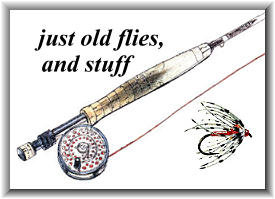"Edward Fitzgibbon, writing as Ephemera, said in his Handbook
of Angling, 1847, 'What is called the buzz form, is an intended
imitation of the natural fly strugling and half drowned. A fly with erect
wings and one without them, or buzz, may be used on the casting line at
the same time, the buzz imitation being the stretcher or tail fly.'
Ephemera also says: 'Some persons call this fly the Marlow Buzz, others
the Lady Bird. At any rate it is intended to imitate a small winged beetle.'
According to James Rennie, Professor of Zoology, Kings College and
author of Alphabet of Scientific Angling, the lady bird, a
little, roundish, reddish beetle with black spots, is also called a dun-cut.
Cotton mentions a dun-cut as a fly to be used in the month of May.
A statement is found that it is also known as the Hazel fly. Another authority
says the Hazel fly is the Welshman's Button, and I add, that almost makes
the Marlow Buzz a Coch-y-bondhu Hackle.
T.C. Hoffman, in the British Anglers' Manual 1839, writes
'The Marlow Buzz is considered a good fly. These hackle or buzz flies are
much more in use than winged flies.'"
The Marlow Buzz is described as:
- Body: Peacock.
- Tip: Gold.
- Hackle: Furnace.
"Seth Green, in 1879, wrote that a 'buzz' was made with the
'hackle standing out the whole length of the body.' That would be
like the present-day palmer tie.
There is a fly called the 'Gray Marlow.'
Who Marlow was I know not, unless he was Kit Marlow, mentioned
by Izaak Walton as the able singer of the Milk Maid's Song."
Quoted section from Fly Patterns and Their
Origins, published by Westshore Publications,
Color photo from Forgotten Flies.
We appreciate use permission!
|



